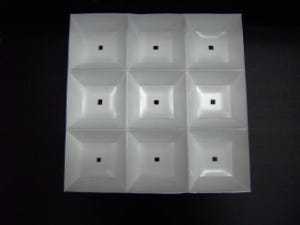Thermoformed microcellular PET for brighter lights, less heat
Japanese lighting company Furukawa Electric (Tokyo) says its has reduced production costs and improved light output by introducing thermoformed versions of its OptoDesign UniBrite technology for LED applications. Based on its MCPET (microcellular polyethylene terephthalate) reflective sheet technology, Furukawa says UniBrite, when thermoformed into complex shapes, has proven beneficial in backlight LCD TV systems; fluorescent and LED signage; and progressive LED designs. The company says MCPET serves to increase illumination intensity between lamps for more balanced lighting.
April 28, 2010
Japanese lighting company Furukawa Electric (Tokyo) says its has reduced production costs and improved light output by introducing thermoformed versions of its OptoDesign UniBrite technology for LED applications. Based on its MCPET (microcellular polyethylene terephthalate) reflective sheet technology, Furukawa says UniBrite, when thermoformed into complex shapes, has proven beneficial in backlight LCD TV systems; fluorescent and LED signage; and progressive LED designs. The company says MCPET serves to increase illumination intensity between lamps for more balanced lighting. It also reduces power consumption and visible striping in signage displays. Where traditional metallic reflection panels absorb red light, changing the color of the reflected light to a darker or bluer tint, the white MCPET sheets reflect light in the visible light range from 400 to 700 nanometer (nm). The sheet, which is capable of reflecting blue and red light almost equally, enables the creation of uniform, bright sign panels. The 1-mm thick foamed MCPET features extra fine cell diameters of 10 microns or less and yields 99% reflectivity and 96% diffused reflectance. The RB grade is certified UL94-HBF and fully compliant with the RoHS.
|
In addition to a smooth surface, Furukawa says MCPET has a shape-holding temperature of 160°C. Furukawa launched the microcellular PET reflective sheet technology in 2007, with it seeing initial use in backlight systems for LCD TVs and fluorescent illuminated signboards. At that time, Furukawa began pitching the color and thermal benefits of its MCPET to the lighting industry, promising brighter light with less heat. The lighting strength and clarity of the MCPET mean fewer light bulbs are required per fixture, which reduces overall energy requirements. Furukawa will be participating in Lightfair International 2010 (Las Vegas; May 12-14). —[email protected]
About the Author(s)
You May Also Like



